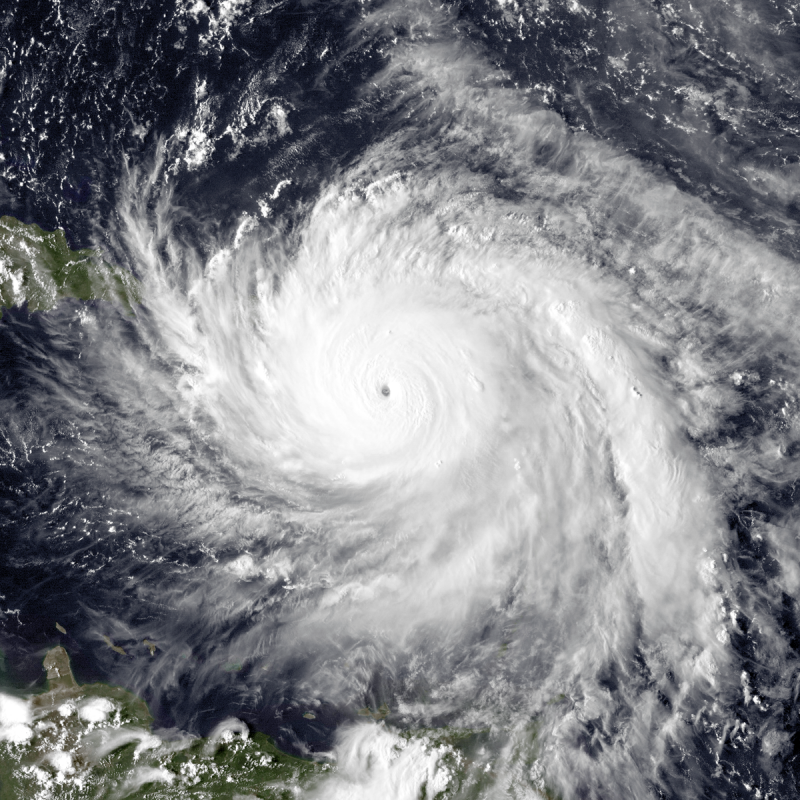
Meteorologists describe 2017’s hurricane season as hyperactive. It was the costliest Atlantic hurricane season on record, displacing the former record holder, 2005. Nearly all the damage was due to three storms – Harvey, Irma, and Maria – which together caused at least $282.16 billion (USD) in damages.
Help EarthSky keep going! Please donate what you can to our annual crowd-funding campaign.
The first of these three monster storms was Hurricane Harvey. It was the eighth named storm, third hurricane, and the first major hurricane of the extremely active 2017 Atlantic hurricane season. Harvey is tied with Hurricane Katrina as the costliest tropical cyclone on record. Much of its damage came from flooding triggered by rainfall in the Houston metropolitan area. According to Popular Science on December 14, 2017, between 24 trillion and 34 trillion gallons of water fell on the Gulf Coast during Harvey, equivalent to the amount of water melted off the West Antarctic Ice Shelf in a single year. Harvey’s floods displaced more than 30,000 people and prompted more than 17,000 rescues. The Texas Tribune said on October 13, 2017, that there were 88 deaths from Harvey, 62 caused by wind, rain and floods (which led to drownings or trees falling on people) and 26 deaths from “unsafe or unhealthy conditions” related to the loss or disruption of services such as utilities, transportation and medical care.

Coming directly after Harvey, Hurricane Irma was the ninth named storm, fourth hurricane, second major hurricane and first Category 5 hurricane of the 2017 Atlantic hurricane season. According to Google, Hurricane Irma was the No. 1 top trending search term of 2017. That’s because Irma had incredibly strong winds, the strongest maximum sustained winds seen in the Atlantic since 2005’s Wilma (which was the most intense tropical cyclone ever recorded in the Atlantic). Irma was the first Category 5 hurricane on record to strike the Leeward Islands in the Caribbean Sea. It became the second-costliest Caribbean hurricane on record, after Maria (see below). It was also the most intense hurricane to strike the continental U.S. since Katrina in 2005, the first major hurricane to make landfall in Florida since Wilma in 2005, and the first Category 4 hurricane to strike the state since Charley in 2004. Wikipedia lists 134 deaths (49 direct, 85 indirect) from Irma.

Coming two weeks after Irma, Hurricane Maria was the thirteenth named storm, eighth consecutive hurricane, fourth major hurricane, second Category 5 hurricane, and the deadliest storm of the hyperactive 2017 Atlantic hurricane season. It’s now regarded as the worst natural disaster on record for Dominica and Puerto Rico. In Puerto Rico, electricity was cut off to 100 percent of the island, and access to clean water and food became limited for most. For months, most families and businesses remained without power, cell phone service was limited, and clean water, food, medicine and fuel were all in very short supply. Less than half of residents had their power restored two months after the storm had passed, and, even today, some communities still have a “boil water” advisory in place. Official estimates originally placed the number of dead at 64. But a new Harvard study – published in late May 2018 in the peer-reviewed New England Journal of Medicine – estimates that at least 4,645 deaths can be linked to the hurricane and its immediate aftermath, making the storm far deadlier than previously thought. Read about the new study in the Washington Post.
In all, 2017 had 17 named storms, 10 hurricanes and 6 major hurricanes. The 2017 season ranks alongside 1936 as the fifth-most active season. 2017 is also one of only six years on record to feature multiple Category 5 hurricanes. It’s the second after 2007 to feature two hurricanes making landfall at that intensity.
Hurricane season for 2018 begins June 1 and ends November 30.
Bottom line: 2017’s hurricane season was the costliest on record, with nearly all the damage due to 3 storms – Harvey, Irma, and Maria.
Help EarthSky keep going! Please donate what you can to our annual crowd-funding campaign.











